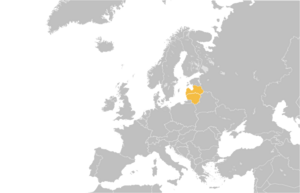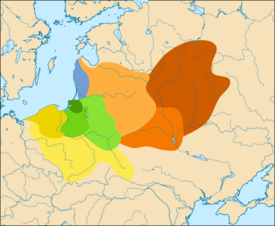Balts facts for kids

Countries with a predominantly Baltic population
|
|
| Total population | |
|---|---|
| 6.5–7.0 million (including the diaspora) |
|
| Regions with significant populations | |
| 2,397,418 | |
| 1,175,902 | |
| Languages | |
| Baltic languages | |
| Religion | |
| Predominantly Roman Catholicism and Protestantism; minority Eastern Orthodoxy and Baltic neopaganism | |
| Related ethnic groups | |
| Slavs | |
The Balts or Baltic peoples are a group of people who live along the eastern coast of the Baltic Sea. They speak Baltic languages. Today, the main Baltic peoples are the Lithuanians and Latvians. These are called East Balts.
There were also West Balts, like the Old Prussians, Curonians, and Sudovians. Their languages and cultures have sadly disappeared over time.
The Balts come from ancient tribes. These tribes were part of the larger Indo-European family. They settled in the area between the Vistula and Daugava rivers. Over many years, they slowly split into West and East Balts.
Around the 5th century CE, the ancestors of the West Balts settled near the eastern Baltic coast. The East Balts lived further inland, in areas that are now Belarus, Ukraine, and Russia. Over time, the area where Balts lived became smaller due to migrations and other groups moving in.
Baltic languages are part of the Balto-Slavic family. This family is a branch of the Indo-European languages. Baltic languages, especially Lithuanian, have kept many old features. This means they are very similar to how ancient languages might have sounded.
Contents
What Does "Baltic" Mean?
The word "Baltic" was first used by a German writer named Adam of Bremen. He used it in the 11th century to talk about the Baltic Sea. He thought the word "Balt" was like "belt," maybe because the sea looked like a belt.
Before this, ancient maps sometimes used names like "Balcia" for an island in the Baltic Sea. For a long time, Germanic languages called the sea the "East Sea." But after about 1600, maps in English started calling it the Baltic Sea.
In 1845, a scholar named Georg Heinrich Ferdinand Nesselmann suggested a special language group for Latvian, Lithuanian, and Old Prussian. He called them "Baltic languages." This name became very popular after Latvia and Lithuania became independent countries in 1918.
History of the Balts
Where Did They Come From?

The Balts are descendants of ancient Indo-European tribes. These tribes settled in a large area. This area stretched from the lower Vistula River to the southeastern shore of the Baltic Sea. It also went up to the Daugava and Dnieper rivers.
Baltic languages, especially Lithuanian, have kept many old features. This might be because the areas where they are spoken have not had many new people moving in.
Some experts have studied the names of rivers in Eastern Europe. They found many river names that seem to come from Baltic languages. This helps us guess where the Balts lived a very long time ago.
For example, some scholars believe the Balts lived as far east as the upper parts of the Volga and Oka rivers. Their southern border might have been the Seym river. This suggests they once lived in a much larger area than today.
Early Times
Over time, the area where the Balts lived became smaller. This happened because other groups moved in and some Balts mixed with them.
One theory says that a western Baltic tribe, the Galindians, moved to the area around modern-day Moscow. This happened around the 4th century AD.
Eventually, the Balts split into West and East Balts. In the 5th century AD, the ancestors of the West Balts settled along the eastern Baltic coast. These included the Old Prussians, Sudovians, and Curonians. The East Balts lived in areas that are now Belarus, Ukraine, and Russia.
Germanic peoples lived to the west of the Balts. By the 1st century AD, the Goths had a kingdom near the Vistula River. As the Roman Empire weakened, large groups of Balts started to move. The Galindians moved east, and later, East Balts moved west.
In the 8th century, Slavic tribes arrived from the Volga regions. By the 13th and 14th centuries, these Slavic tribes had reached the areas where Balts and Belarusians live today. Many other Eastern and Southern Balts gradually mixed with Slavs.
Middle Ages

In the 12th and 13th centuries, the Balts faced many challenges. There were internal fights and invasions from groups like the Ruthenians and Poles. Later, the Teutonic Order, a group of knights, expanded into their lands.
These events led to the near disappearance of groups like the Galindians, Curonians, and Yotvingians. The Old Prussians slowly became more like Germans or Lithuanians between the 15th and 17th centuries. This happened especially after the Protestant Reformation in Prussia.
However, the cultures of the Lithuanians and Latgalians (who became Latvians) survived. They are the ancestors of the people in the modern countries of Latvia and Lithuania.
Old Prussian was very similar to other extinct Western Baltic languages. These included Curonian, Galindian, and Sudovian. It was less similar to the surviving Eastern Baltic languages, Lithuanian and Latvian. For example, the Prussian word seme (zemē), Latvian zeme, and Lithuanian žemė all mean "land" in English.
Culture and Beliefs
The Balts originally had their own unique Baltic religion. They worshipped many gods and spirits connected to nature. Over time, they slowly became Christian. This happened during the Northern Crusades in the Middle Ages.
Different Baltic peoples, like the Latvians, Lithuanians, and Old Prussians, had their own special stories about gods and heroes.
Today, Lithuanians have strong historical ties to Poland. Many of them are Roman Catholic. Latvians have strong historical ties to Northern Germany and Scandinavia. Many Latvians are not religious. In recent times, some people have tried to bring back the old Baltic religion. This is called Baltic neopaganism.
Genetics
Scientists study the genes of people to understand their history. Balts are part of a "North European" gene cluster. This group also includes Germanic peoples and some Slavic groups.
Studies show that the eastern Baltic area was first lived in by "Western Hunter-Gatherers." These ancient people had light eye and skin colors. They also had a lot of a certain type of ancestry.
Later, during the Stone Age, more "Eastern Hunter-Gatherers" mixed with them. Then, during the Copper and Bronze Ages, new groups arrived. These groups brought new genes from the steppes (large grasslands).
Modern Balts have less ancestry from early farmers and more from ancient hunter-gatherers. This is compared to many other groups in Europe.
Who Are the Baltic Peoples Today?
Modern-day Baltic peoples
- East Baltic peoples
- Latvians
- Latgalians
- Lithuanians
- Aukštaitija ("highlanders")
- Samogitians ("lowlanders")
- Latvians
See also
- East Baltic languages
- West Baltic languages

